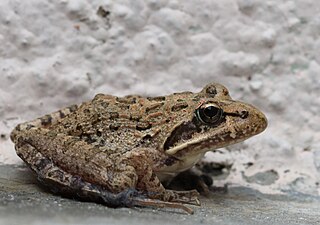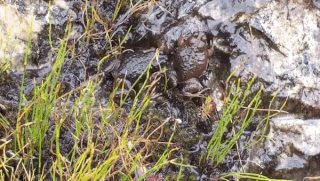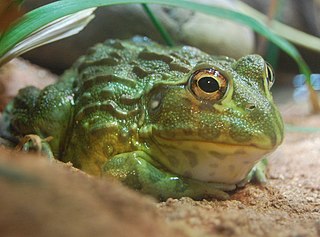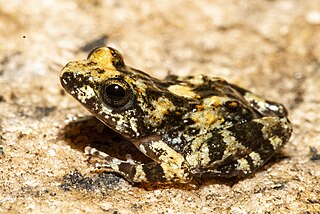
Strongylopus is a genus of pyxicephalid frogs native to Africa. They are found in the area from southwestern South Africa and Namibia to northern Tanzania. Their common name is stream frogs.

Arthroleptis francei is a species of frog in the family Arthroleptidae. It is found in Mount Mulanje in southern Malawi and in Mount Namuli and Mount Mabu in northern Mozambique. Records from the Zomba Massif (Malawi) require confirmation. Common names Ruo River screeching frog and France's squeaker have been coined for it.

Mertensophryne usambarae is a critically endangered species of toad in the family Bufonidae. It is endemic to the foothills of the East Usambara Mountains, northeastern Tanzania.

Hyperolius spinigularis is a species of frog in the family Hyperoliidae. It is found in the Mulanje Massif in southern Malawi and the Namuli Massif in adjacent Mozambique. Records from Tanzania refers to other species. Males of this species have characteristic small spines during the breeding season. Its common names are spiny-throated reed frog, spiny reed frog, and Mulanje reed frog.

Leptopelis argenteus, also known as the silvery tree frog or triad tree frog, is a species of frog in the family Arthroleptidae. It is found in coastal Kenya and Tanzania and south to northern Mozambique, southern Malawi, and eastern highlands of Zimbabwe.

Leptopelis broadleyi is a species of frog in the family Arthroleptidae of uncertain status. The Amphibian Species of the World, the IUCN SSC Amphibian Specialist Group, and the African Amphibians do not recognize it, but instead consider it synonym with Leptopelis argenteus. However, the AmphibiaWeb recognizes it as a valid species.

Leptopelis flavomaculatus is a species of frog in the family Arthroleptidae. It is found in the lowlands eastern and southern Africa, from Mozambique north of the Save River and Zimbabwe to Malawi, eastern Tanzania, and coastal Kenya. Its common names are yellow-spotted tree frog, brown-backed tree frog, brown forest treefrog, and Johnston's treefrog.

Leptopelis macrotis, sometimes called the big-eyed forest tree frog, is a species of frog in the family Arthroleptidae. It is found in the rainforests of Sierra Leone, southern Guinea, Liberia, Ivory Coast, and southern Ghana. Notice that similar common name "big-eyed tree frog" is sometimes used for Leptopelis vermiculatus from Tanzania and for Litoria exophthalmia from New Guinea.
Leptopelis parbocagii, also known as Lake Upemba forest treefrog or cryptic tree frog, is a species of frog in the family Arthroleptidae. It is found in Angola, the Democratic Republic of the Congo, Malawi, Mozambique, Tanzania, and Zambia. The specific name parbocagii refers to its similarity to Leptopelis bocagii.

The Hogsback frog, or Rattray's forest frog, is a species of frog in the family Pyxicephalidae. It is one of three species within the genus Anhydrophryne. It is endemic to the Eastern Cape province of South Africa.

Cacosternum is a genus of frog in the family Pyxicephalidae that are found in southern and eastern Africa. They have many common names, including cacos, dainty frogs, and metal frogs.

Ericabatrachus is a genus of frogs in the family Petropedetidae endemic to the Bale Mountains in Ethiopia. It is monotypic, being represented by the single species Ericabatrachus baleensis, commonly known as the Bale Mountains frog.
Nothophryne is a genus of frogs known as mongrel frogs. They are found in southern Malawi and northern Mozambique. Until 2018, only one species in the genus was known, Nothophryne broadleyi. As of January 2019, there are five known species:
Phrynobatrachus kinangopensis is a species of frog in the family Phrynobatrachidae. It is endemic to the Kenyan Highlands east of the Great Rift Valley. Both the scientific name and its common names, Kinangop river frog and Kinangop puddle frog, refer to its type locality, Mount Kinangop.

Poyntonia, is a monotypic frog genus in the family Pyxicephalidae. It was named after J.C. Poynton, a notable herpetologist who worked in southern Africa.

Amietia delalandii, also known as the Delalande's river frog, the Drakensberg frog, Drakensberg river frog, or Sani Pass frog, is a species of southern African river frog in the family Pyxicephalidae. It is found in Lesotho, South Africa, Mozambique, Malawi, Zimbabwe, and possibly Zambia. It is the sister species to A. vertebralis.
Aubria masako is a species of frog in the family Pyxicephalidae. It is found in southeastern Cameroon, eastern Gabon, southwestern Central African Republic, northern Republic of the Congo, and eastward to the central Democratic Republic of the Congo, with one (doubtful) record from Angola; it might occur in Equatorial Guinea. Common names Masako ball frog and Masako fishing frog have been coined for this species. Whether it is distinct from Aubria subsigillata has been debated, but at present it is treated as a valid species.
Aubria subsigillata, commonly known as the brown ball frog or the West African brown frog, is a species of frog belonging to the family Pyxicephalidae. It has a discontinuous distribution from southern Guinea through Liberia and Ivory Coast, and from Nigeria to southern Cameroon, and Equatorial Guinea to Gabon. However, the species delimitation differs between sources, and the International Union for Conservation of Nature has adopted a narrower view where this species only occurs in Cameroon and southward.

The Pyxicephalidae are a family of frogs currently found in sub-Saharan Africa. However, in the Eocene, the taxon Thaumastosaurus lived in Europe.

Nothophryne unilurio is a species of frog in the family Pyxicephalidae described in 2018. It is endemic to Taratibu Nills in northern Mozambique. The specific name unilurio is derived from Lúrio University, or Unilúrio, the name of a Mozambican university responsible for the research that culminated with the finding of the new species.















